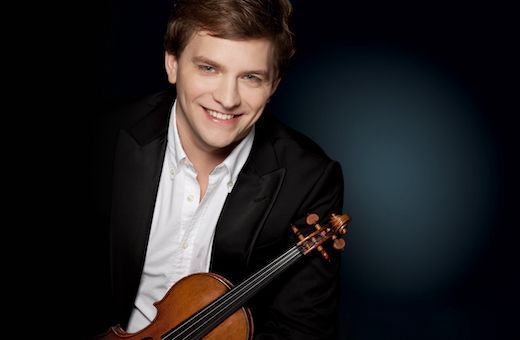Both Tchaikovsky’s Violin Concerto and Shostakovich’s Ninth Symphony had a hard time of it after their respective premieres. Not fulfilling expectations is as bad as doing something radically different. Both have consequences. Additionally, in Shostakovich’s case, the failure to dedicate the “non-ninth” Ninth to Stalin meant that after seeing the light of day in 1945, it was banned until after the dictator’s death.

There are some performances in which the spirit of the rendition seems to belie actual clock time, rather like the wind-chill factor making temperatures seem colder than they really are. Valeriy Sokolov, the soloist in this Tchaikovsky, accompanied by Aurora Orchestra conducted by Nicholas Collon, made everything sound unusually slow and deliberate. That notwithstanding, there were princely qualities on display, not least a technical immaculacy and a vast range of colour, from a bleached, ethereal quality to a deeply burnished amplitude in the lower register.
The way Sokolov turned the first movement into a quasi-delicate salon piece was part of the story. He was always keenly focused on his instrument, head bowed, occasionally turning to the conductor, but without his eyes ever reaching out to the audience. It was one of the most inward performances I have heard in a long while, with distant echoes of the composer’s Sérenade mélancolique resonating throughout. Even more remarkably, Sokolov tapped into a deep well of loneliness. There were no firecrackers; instead the soloist served up a salver of glasses with iced vodka. As if to underline traditional expectations, Collon moved the tempo on quite smartly, moving into a much higher gear than his soloist, most obviously in the orchestral introduction to the first movement cadenza, and then by applying judicious daubs of bright colour to the bleak landscape of the Finale.
Tom Service, a fired-up presence on stage, together with Collon are in danger of becoming one of the greatest double acts in musical presentation. There is much to be said for modern maestros talking to their audiences, but even more for the way in which these two gentlemen, rather like master clockmakers, took apart the structure of Shostakovich’s Ninth and then cleverly put it all back together again. This would not have been so satisfying without the superlative playing of Aurora Orchestra throughout, entirely from memory, with pinpoint precision in the strings, a choral-like weight from the woodwind and virtuosic displays from the brass, all delivered with infectious enthusiasm.
Which leaves open the question about the true nature of this particular Ninth. The composer himself described it as “a merry little piece”, and a case can be made for it being an opera buffa symphony. Service described it as “a musical circus ride” and indeed, with its prominent parts for solo trumpet, trombone and woodwind principals, it provides manifold opportunities for individual extroversion, all held together most persuasively by “the ringmaster”. Collon’s ear for characterisation made all the ideas tell: the militaristic, goose-stepping rhythms of the first movement, along with simulated gunfire from horns and side-drum as well as snappy trombone solos; the hiemal effects of the waltz sequence accompanied by ominous horns in the Moderato; the swirling and whirling dizziness of the Presto; and not least the mournfully expressionistic bassoon solo in the slow movement.
Reinforcing the versatility of his players, Collon instructed them to repeat the Finale as an encore, with individuals standing both on the platform and spread out and around the front stalls, creating an immersive effect far from the experience of most audiences. It is testament to Aurora’s innovative work that from this September it will become a Resident Orchestra at Southbank.


